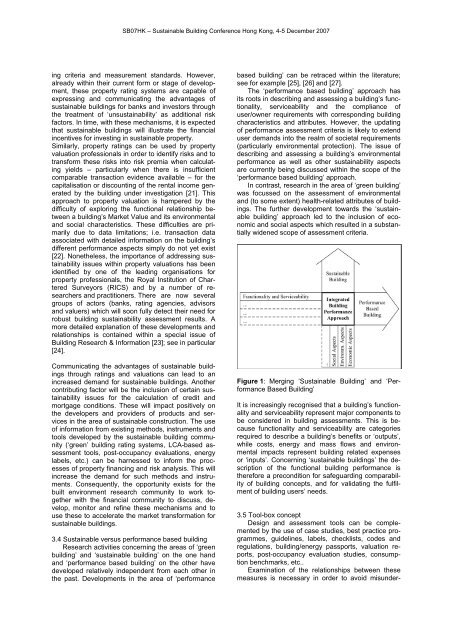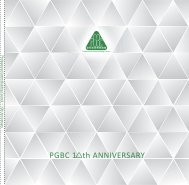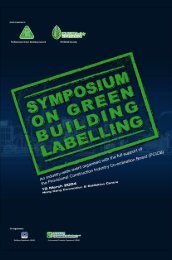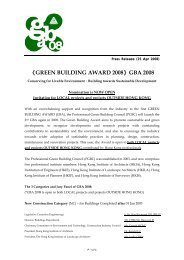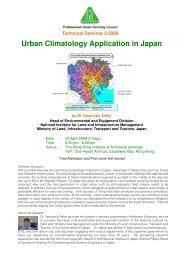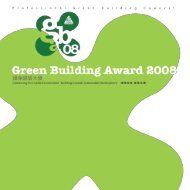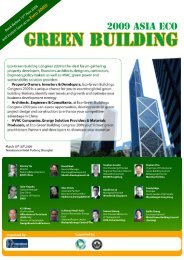Paper - The Professional Green Building Council
Paper - The Professional Green Building Council
Paper - The Professional Green Building Council
You also want an ePaper? Increase the reach of your titles
YUMPU automatically turns print PDFs into web optimized ePapers that Google loves.
SB07HK – Sustainable <strong>Building</strong> Conference Hong Kong, 4-5 December 2007<br />
ing criteria and measurement standards. However,<br />
already within their current form or stage of development,<br />
these property rating systems are capable of<br />
expressing and communicating the advantages of<br />
sustainable buildings for banks and investors through<br />
the treatment of ‘unsustainability’ as additional risk<br />
factors. In time, with these mechanisms, it is expected<br />
that sustainable buildings will illustrate the financial<br />
incentives for investing in sustainable property.<br />
Similarly, property ratings can be used by property<br />
valuation professionals in order to identify risks and to<br />
transform these risks into risk premia when calculating<br />
yields – particularly when there is insufficient<br />
comparable transaction evidence available – for the<br />
capitalisation or discounting of the rental income generated<br />
by the building under investigation [21]. This<br />
approach to property valuation is hampered by the<br />
difficulty of exploring the functional relationship between<br />
a building’s Market Value and its environmental<br />
and social characteristics. <strong>The</strong>se difficulties are primarily<br />
due to data limitations; i.e. transaction data<br />
associated with detailed information on the building’s<br />
different performance aspects simply do not yet exist<br />
[22]. Nonetheless, the importance of addressing sustainability<br />
issues within property valuations has been<br />
identified by one of the leading organisations for<br />
property professionals, the Royal Institution of Chartered<br />
Surveyors (RICS) and by a number of researchers<br />
and practitioners. <strong>The</strong>re are now several<br />
groups of actors (banks, rating agencies, advisors<br />
and valuers) which will soon fully detect their need for<br />
robust building sustainability assessment results. A<br />
more detailed explanation of these developments and<br />
relationships is contained within a special issue of<br />
<strong>Building</strong> Research & Information [23]; see in particular<br />
[24].<br />
Communicating the advantages of sustainable buildings<br />
through ratings and valuations can lead to an<br />
increased demand for sustainable buildings. Another<br />
contributing factor will be the inclusion of certain sustainability<br />
issues for the calculation of credit and<br />
mortgage conditions. <strong>The</strong>se will impact positively on<br />
the developers and providers of products and services<br />
in the area of sustainable construction. <strong>The</strong> use<br />
of information from existing methods, instruments and<br />
tools developed by the sustainable building community<br />
(‘green’ building rating systems, LCA-based assessment<br />
tools, post-occupancy evaluations, energy<br />
labels, etc.) can be harnessed to inform the processes<br />
of property financing and risk analysis. This will<br />
increase the demand for such methods and instruments.<br />
Consequently, the opportunity exists for the<br />
built environment research community to work together<br />
with the financial community to discuss, develop,<br />
monitor and refine these mechanisms and to<br />
use these to accelerate the market transformation for<br />
sustainable buildings.<br />
3.4 Sustainable versus performance based building<br />
Research activities concerning the areas of ‘green<br />
building’ and ‘sustainable building’ on the one hand<br />
and ‘performance based building’ on the other have<br />
developed relatively independent from each other in<br />
the past. Developments in the area of ‘performance<br />
based building’ can be retraced within the literature;<br />
see for example [25], [26] and [27].<br />
<strong>The</strong> ‘performance based building’ approach has<br />
its roots in describing and assessing a building’s functionality,<br />
serviceability and the compliance of<br />
user/owner requirements with corresponding building<br />
characteristics and attributes. However, the updating<br />
of performance assessment criteria is likely to extend<br />
user demands into the realm of societal requirements<br />
(particularly environmental protection). <strong>The</strong> issue of<br />
describing and assessing a building’s environmental<br />
performance as well as other sustainability aspects<br />
are currently being discussed within the scope of the<br />
‘performance based building’ approach.<br />
In contrast, research in the area of ‘green building’<br />
was focussed on the assessment of environmental<br />
and (to some extent) health-related attributes of buildings.<br />
<strong>The</strong> further development towards the ‘sustainable<br />
building’ approach led to the inclusion of economic<br />
and social aspects which resulted in a substantially<br />
widened scope of assessment criteria.<br />
Figure 1: Merging ‘Sustainable <strong>Building</strong>’ and ‘Performance<br />
Based <strong>Building</strong>’<br />
It is increasingly recognised that a building’s functionality<br />
and serviceability represent major components to<br />
be considered in building assessments. This is because<br />
functionality and serviceability are categories<br />
required to describe a building’s benefits or ‘outputs’,<br />
while costs, energy and mass flows and environmental<br />
impacts represent building related expenses<br />
or ‘inputs’. Concerning ‘sustainable buildings’ the description<br />
of the functional building performance is<br />
therefore a precondition for safeguarding comparability<br />
of building concepts, and for validating the fulfilment<br />
of building users’ needs.<br />
3.5 Tool-box concept<br />
Design and assessment tools can be complemented<br />
by the use of case studies, best practice programmes,<br />
guidelines, labels, checklists, codes and<br />
regulations, building/energy passports, valuation reports,<br />
post-occupancy evaluation studies, consumption<br />
benchmarks, etc..<br />
Examination of the relationships between these<br />
measures is necessary in order to avoid misunder-


